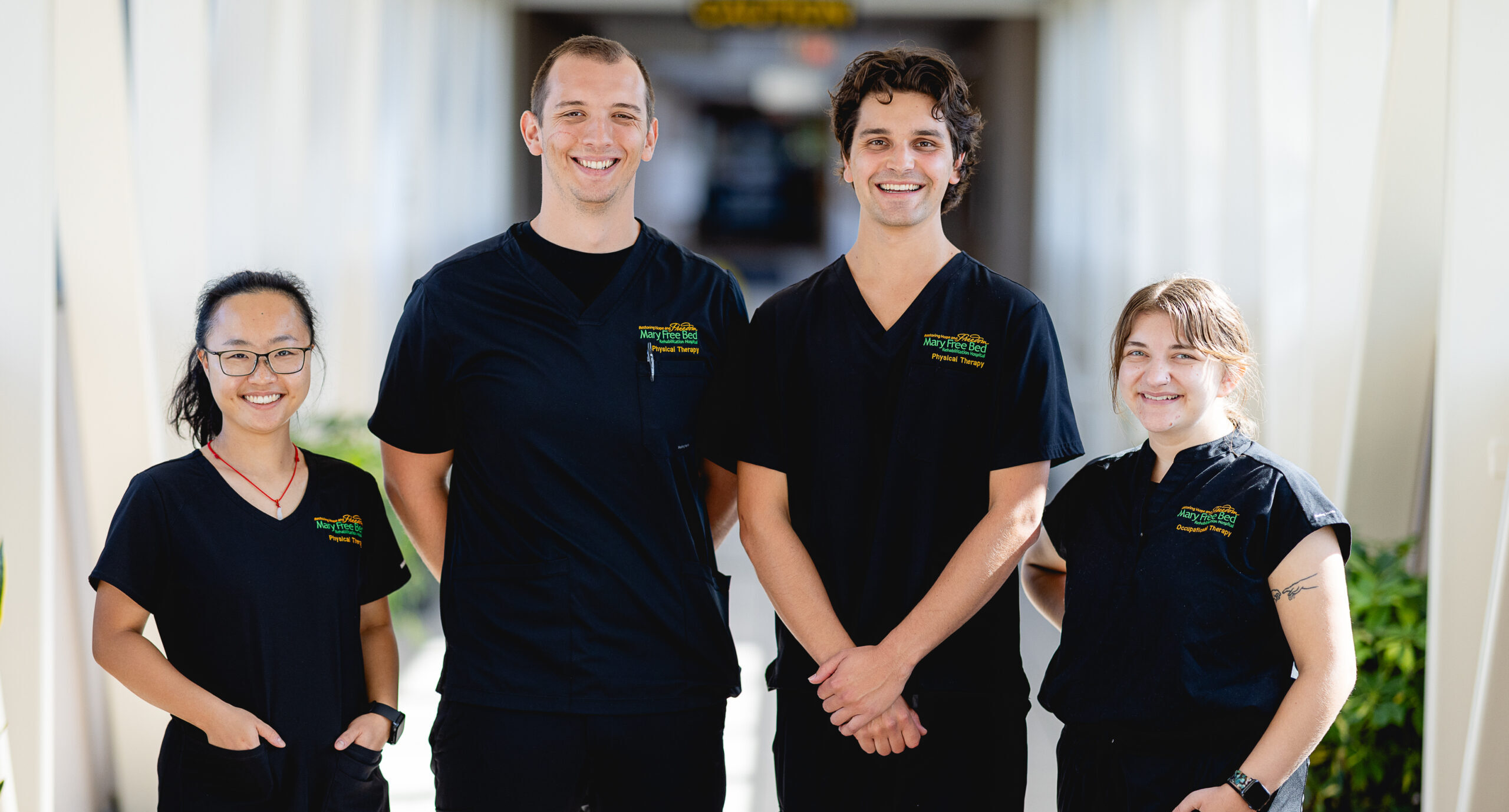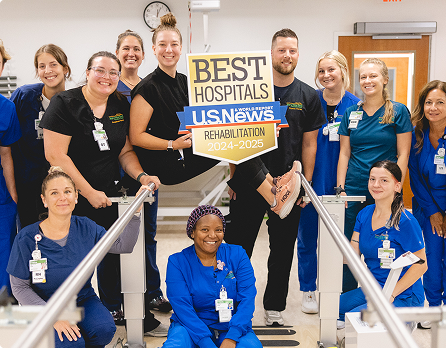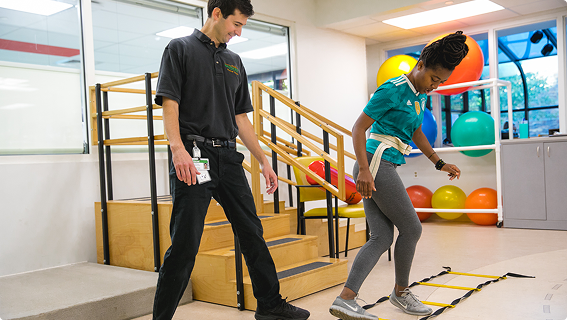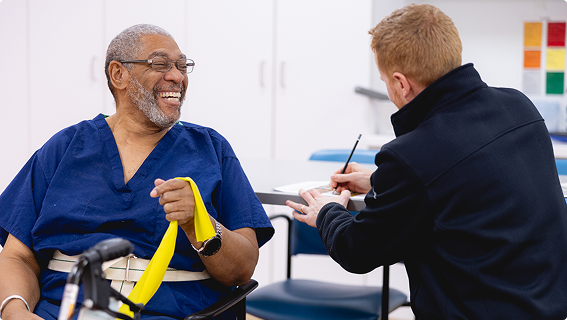Advanced Training with Mary Free Bed & GVSU
Neurologic Physical Therapy Residency
Mary Free Bed Rehabilitation Hospital, in partnership with Grand Valley State University, offers an exceptional training opportunity through the Neurologic Physical Therapy Residency program. This accredited, post-professional residency is designed to develop advanced skills, clinical expertise, and leadership in neurologic physical therapy.
Residents refine their clinical reasoning through dedicated mentoring with expert neurologic therapists while working in a collaborative, interdisciplinary environment.
Program Highlights
Our residency program provides unique learning opportunities that empower participants to specialize in neurologic care. Residents will:
Advanced Training & Leadership Development
Residents gain advanced knowledge, skills, and expertise in neurologic physical therapy, preparing them for specialty practice and leadership roles in their field.
Interdisciplinary Collaboration
Residents work alongside an interdisciplinary team to help restore hope and freedom for patients with diverse neurologic conditions.
Evidence-Based Practice
Residents contribute to and effectively implement evidence-based clinical practice while sharing their expertise with students, clinicians, and patients and their families—all with the highest ethical standards.

No Place Like Mary Free Bed: A specialized Neurologic PT Residency to Grow, Learn + Make an Impact


The Mary Free Bed Rehabilitation Hospital and Grand Valley State University Physical Therapy Residency is accredited by the American Board of Physical Therapy Residency and Fellowship Education as a post-professional residency program for physical therapists in neurologic physical therapy.
Clinical Curriculum
The Neurologic Physical Therapy Residency at Mary Free Bed and Grand Valley State University is built on the latest description of Specialty Practice in Neurologic Physical Therapy from the American Physical Therapy Association. This rigorous curriculum offers diverse clinical experiences to develop advanced skills and expertise in neurologic physical therapy.
Clinical Rotations
- Inpatient Experience: Residents will work within Mary Free Bed’s 167-bed rehabilitation hospital, rotating with brain injury, spinal cord injury, and stroke rehabilitation teams.
- Outpatient Rotation: Residents gain experience across neurologic diagnoses, focusing primarily on vestibular rehabilitation and post-concussion care.
- Acute Care and Transitional Living Settings: Established partnerships with local organizations provide additional hands-on learning in inpatient acute care and transitional living environments.
Professional Development Opportunities:
- Specialty Clinics & Services: Residents have the opportunity to observe and participate in specialty clinics (Post-Concussion, Muscular Dystrophy, ALS) and rehabilitation services, including custom wheelchair seating, adaptive technology, Orthotics & Prosthetics + Bionics, videofluoroscopy swallowing studies, and Motion Analysis Laboratory.
- Journal Clubs & Case Reviews: Residents lead monthly journal clubs and case reviews to promote evidence-based practice and facilitate integrating clinical decision-making with current research into patient care.
This comprehensive program combines clinical excellence, professional mentorship, and innovative research to prepare residents for advanced specialty practice in neurologic physical therapy.
Didactics
The curriculum for the Mary Free Bed and Grand Valley State University Neurologic Physical Therapy Residency is built on the latest Description of Specialty Practice in Neurologic Physical Therapy from the American Physical Therapy Association. This dynamic program blends didactic learning with practical application to provide residents with advanced specialty-specific knowledge.

Didactic Learning Formats:
Residents will engage with a variety of educational methods, including:
- Webinars
- Self-guided modules
- Directed readings
- Hands-on practice
- Mentor-led discussions
- Collaborative meetings with therapy residents/fellows
- Interactive learning through the Institute for Knowledge Translation
Residents are also encouraged to pursue continuing education opportunities and will share their knowledge with the rehabilitation team, fostering a collaborative learning environment.
Scientific Inquiry & Research:
Residents dedicate time to a scientific inquiry project, working closely with a Grand Valley State University faculty mentor. This project allows residents to explore their specific area of interest, contributing to advancements in neurologic physical therapy.
Teaching & Community Engagement:
- Teaching Experience: Residents gain valuable teaching skills by assisting in GVSU’s Department of Physical Therapy neurologic lab and classroom settings.
- Pro Bono Clinic Oversight: Residents supervise GVSU DPT students in a pro bono clinic, providing care to uninsured and underinsured members of the Grand Rapids community.
This residency offers a well-rounded education that combines clinical expertise, research, and teaching opportunities, preparing residents for advanced practice and leadership in neurologic physical therapy.
Faculty
- Board-certified clinical specialist in neurologic physical therapy
- Grand Valley State University; BS in Clinical Exercise Science, minor in Spanish, DPT, Grand Valley State University
- Board-certified clinical specialist in neurologic physical therapy
- DPT, Central Michigan University; BS Health Fitness and Rehabilitation
- Board-certified clinical specialist in neurologic physical therapy
- Certified Stroke Rehabilitation Specialist
- Focus areas: vestibular, general neuro, SCI
- DPT, Trine University; BA Exercise Science Hope College
- DPT Central Michigan University, BS Health Fitness and Rehabilitation
- Board-certified clinical specialist in neurologic physical therapy
- Certified Brain Injury Specialist
- DPT, Grand Valley State University; BS Sports Medicine/Athletic Training, Central Michigan University
- Focus areas: Post-concussion, vestibular, brain injury, balance disorders
- MS PT, Grand Valley State University
Job Details
Residents have full-time status as Mary Free Bed employees, which includes full-time benefits. They’re also appointed guest faculty at Grand Valley State University, which includes access to university resources.
Fees: $700 for curriculum
Eligibility
- You must be a physical therapist or in their final year of an accredited physical therapy program.
- State of Michigan licensure is required prior to beginning the residency.
- Residents must be a member of the APTA.

Questions
- If you have further questions, email recruitment@maryfreebed.com.
- For program-specific questions, email PTneuroresidency@maryfreebed.com.

Want to apply?
Applications open October for the 2026-2027 residency year with a deadline of February 15, 2026 and a start date of September 2026.
Please submit your application through the RF-PTCAS system. Click here to begin the process.
If you have further questions, check out our FAQ or email recruitment@maryfreebed.com.
For program-specific questions, email PTneuroresidency@maryfreebed.com.
 Program Goals
Program Goals
These goals are evaluated through 15 key objectives.
Graduate Advanced Clinicians
Equip residents with post-professional experiential learning in neurologic physical therapy, integrating advanced patient-centered clinical practice, interdisciplinary team-based collaboration, and a strong theoretical foundation in rehabilitation science.
Promote Evidence-Based Care
Develop clinicians who deliver high-quality, evidence-based services to the community with the highest ethical standards.
Foster Ethical Decision-Making
Empower physical therapists to practice ethical clinical decision-making while demonstrating professionalism and virtuous behavior.
Advance the Profession
Prepare physical therapists to contribute to the profession and the broader health care community through evidence-based practice, teaching, and advancing the body of knowledge in neurologic physical therapy.
Maintain Excellence
Ensure the residency program remains a high-caliber, accredited program through adherence to ABPTRFE standards.
Prepare for Certification
Develop the skills, knowledge, and attributes necessary for residents to attain Neurologic Clinical Specialist Certification.
 Program Outcomes
Program Outcomes
These outcomes are assessed using 33 key performance indicators.
Advanced Clinical Competence
Residents will demonstrate expertise in patient-centered clinical care and foundational knowledge for neurologic clinical practice consistent with the client/patient management areas of the Description of Residency Practice – Neurology.
High-Quality Evidence-Based Practice
Residents will deliver high-quality, evidence-based clinical services, applying best-practice strategies, innovative techniques, and applied knowledge in neurologic physical therapy to the community.
Scientific Inquiry Proficiency
Residents will develop skills in scientific inquiry to guide clinical practice and contribute to the growing evidence base in neurologic physical therapy.
Teaching & Mentorship
Residents will effectively teach and mentor students, peers, and other healthcare professionals in neurologic physical therapy.
Ethical Excellence
Residents will exhibit high standards of ethical decision-making, professionalism, and virtuous behavior.
Board Examination Preparedness
Residents will meet the qualifications and be prepared to sit for the ABPTS Neurologic Clinical Specialist board examination.
Program Success
- Graduation rate: 100%
- Program goal passing rate: 95%
- Participant outcomes passing rate: 100%
- ABPTS Exam pass rate: 100%
 Research
Research
Each year, the resident presents his or her findings at Mary Free Bed Rehabilitation Hospital’s Interdisciplinary Grand Rounds. Most residents also present their findings at a national level as either a poster or platform presentation. Listed below are citations for the residents’ presentations and links to the published works.
Wittry, B, Harro C. Improving healthcare professional communication across care settings in stroke rehabilitation: A quality improvement project.
Research poster and platform presentation at Academy of Neurologic Physical Therapy Annual Conference, Minneapolis, MN, Sept 28-30, 2023.
Kelch A, Harro C. Physical Therapy Interventions in a Patient with Nontraumatic Incomplete Spinal Cord Injury Secondary to Metastatic Lung Cancer: A Case Report.
Physiotherapy Theory and Practice, 2022: 38 (12): https://www.tandfonline.com/eprint/JS24DAAHXTAHC9HVQDNC/full?target=10.1080/09593985.2021.1923094
Evans J, Harro CC. High Intensity Gait Training for Patient With Apraxia Following Ischemic and Hemorrhagic Stroke.
Research poster presentation at American Congress of Rehabilitation Medicine Annual Conference, Chicago, IL, Nov 8-11, 2022
Cherven A, Harro CC. Physical Therapy Interventions in a Patient with Traumatic Brain Injury and Severe Contraversive Pushing: A Case Report.
Research platform presented at Michigan Physical Therapy Association Annual Fall Conference, Oct 2020. Research poster presentation at Annual Academy of Neurologic Physical Therapy Annual Conference, October 2021.
Kuster R, Harro CC. Clinical Decision-making for Locomotor Training in a Patient with C4-Brown Séquard Syndrome: A Case Report.
American Congress of Rehabilitation Medicine: 97th Annual Conference, Atlanta GA (virtual); Oct 14-17, 2020
Kelch A, Harro CC. Physical Therapy Interventions in a Patient with Incomplete SCI and Metastatic Cancer: A Case Report.
Research poster presentation at American Congress of Rehabilitation Medicine Annual Conference, Chicago, IL, Nov 5-8, 2019
Harro CC, Kaiser MR, Maurer PM. Ankle foot orthotic prescription and gait outcomes in patients with stroke or brain injury in inpatient rehabilitation.
Research poster accepted for the American Physical Therapy Association NEXT conference, June 2018.
Maurer PM, Harro CC, Kaiser MR. Clinical Decision-Making Regarding Ankle Foot Orthotic Prescription in Patients with Stroke or Brain Injury during Inpatient Rehabilitation.
Research poster accepted for American Physical Therapy Association NEXT conference, June 2018.
Ayotte S, Harro CC. Effects of an Individualized Aerobic Exercise Program in Individuals with a Brain Tumor Undergoing Inpatient Rehabilitation: A Feasibility Study.
Oncol 2017: 35(4) 163-171. https://journals.lww.com/rehabonc/Abstract/2017/10000/Effects_of_an_Individualized_Aero
bic_Exercise.3.aspx
Hudson K, Harro C, Ayotte S. Effects of an Individualized Aerobic Exercise Program in Individuals with a Brain Tumor Undergoing Inpatient Rehabilitation: A Feasibility Study.
Arch Phys Med Rehabil. 2016;97: e28. {Published Abstract} Research Poster presented at the American Congress of Rehab Medicine (ACRM) Annual Conference. Chicago IL, 2017.
Engelsma J, Gamble A, Harro CC, Farris J: PocketPT – A Personalized Therapeutic Game Platform;
Journal of Computer Games and Multimedia. 2014; 3 (4): 55-62
Harro CC, Gamble A: Application of an Innovative and Interactive Gaming System in Individualized Therapeutic Intervention: A Case Series.
Platform presented at Michigan Physical Therapy Association Annual Fall Conference, Oct. 11-12, 2013
Gorman SL, Harro C, Platko C. Validity and responsiveness of the Function in Sitting Test (FIST) in adults in inpatient rehabilitation: A preliminary analysis.
J Rehab Med 2013; 6 (Suppl 53): 99
Gorman SL, Harro C, Platko C. Validity and responsiveness of the Function in Sitting Test (FIST) in adults in inpatient rehabilitation: A preliminary analysis.
Research platform presented at 7th World Congress of the International Society of Physical and Rehabilitation Medicine (ISPRM2013), Beijing, China, June 16-20, 2013
Gorman S, Harro CC; Platko C. Function in Sitting Test Admission Score Predicts Inpatient Rehabilitation Discharge Destination.
Research poster presentation APTA Academy of Neurology and Academy of Pediatric Physical Therapy; IV Step Conference 2016: Prevention, Prediction, Plasticity, and Participation. Columbus OH, July 16, 2016
Gorman SL, Harro CC, Platko C, Greenwald C. Examining the Function in Sitting Test for Validity, Responsiveness, and Minimal Clinically Important Difference in Inpatient Rehabilitation.
Arch Phys Med Rehabil 2014; 95: 2304-2011 http://www.archives-pmr.org/article/S0003-9993(14)00965-4/abstract
Harro CC, Chapin M, Bontregar K, Campbell SC. Effects of Botulinum Toxin injections into the Rectus Femoris muscle on gait function in stiff knee gait following brain injury or stroke.
JNPT 2014; 39 (1): 75. {Published Abstract} Research Poster presented at American Physical Therapy Association Combined Sections Meeting, Las Vegas, NV, Feb 3-6, 2014
Jenkins L, Harro CC, O’Conner E: Evaluation of Outcomes of Vestibular-Related Dysfunction in Mild Traumatic Brain Injury.
Research Poster presented at Physical Therapy 2008: Annual Conference & Exposition of the American Physical Therapy Association; San Antonio, June 11-14, 2008
Harro CC, Jenkins L, O’Conner E: Examination of Vestibular-Related Dysfunction in Mild Traumatic Brain Injury.
Research Poster presented at Physical Therapy 2008: Annual Conference & Exposition of the American Physical Therapy Association; San Antonio, June 11-14, 2008
Hammond S, Harro CC: Vestibular Evaluation in Individuals with Mild Brain Injury.
J Neurol Phys Ther 2006;29(4):209. {Published abstract} Research Poster presented at Combined Sections Meeting of the American Physical Therapy Association, San Diego CA, 2/2006.
Simon T, Harro CC: Reliability and Validity of the Dynamic Gait Index in Individuals with Brain Injury.
Research Poster presented Michigan Physical Therapy Association Annual Fall Conference, Oct 10-11, 2008, Frankenmuth, MI
Simon T, Harro CC: Reliability and Validity of the Dynamic Gait Index in Individuals with Traumatic Brain Injury.
J Neurol Phys Ther 2005; 28 (3), 180. {Published abstract} Research poster presentation at Combined Sections Meeting of the American Physical Therapy Association, New Orleans, 2/2005
Vanderheide M, Harro CC. Center of Mass Motion During Walking in Moderate and Severe Traumatic Brain Injury.
J Neurol Phys Ther 2003;27(4): 184. {Published abstract}. Research platform presentation at Combined Sections Meeting of the APTA, Nashville, TN 2004.